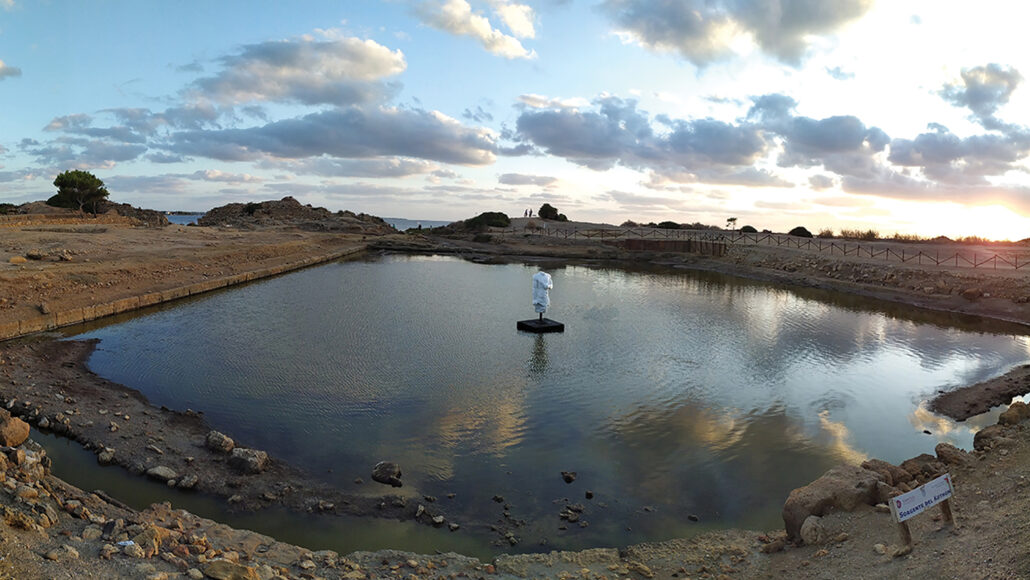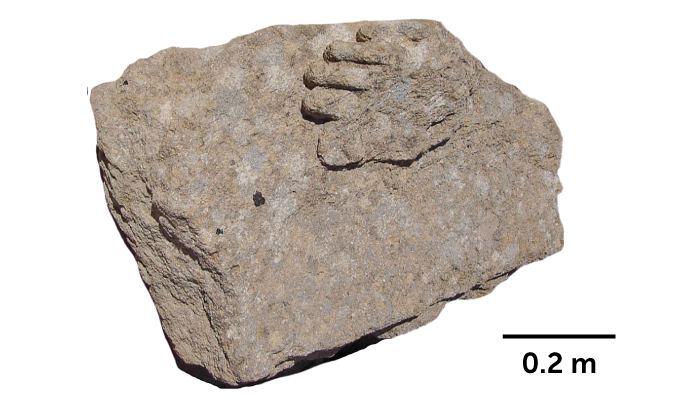A big pool on a tiny island helped Phoenicians track the stars and their gods

Shown after excavations, a sacred pool built by Phoenicians around 2,550 years ago on a tiny Mediterranean island includes a replica of a statue of the god Ba’al at its center.
SAPIENZA UNIVERSITY OF ROME EXPEDITION TO MOTYA
By Bruce Bower
MARCH 16, 2022
On a tiny island off Sicily’s west coast, a huge pool long ago displayed the star-studded reflections of the gods.
Scientists have long thought that an ancient rectangular basin, on the island of Motya, served as an artificial inner harbor, or perhaps a dry dock, for Phoenician mariners roughly 2,550 years ago. Instead, the water-filled structure is the largest known sacred pool from the ancient Mediterranean world, says archaeologist Lorenzo Nigro of Sapienza University of Rome.
Phoenicians, who adopted cultural influences from many Mediterranean societies on their sea travels, put the pool at the center of a religious compound in a port city also dubbed Motya, Nigro reports in the April Antiquity.
The pool and three nearby temples were aligned with the positions of specific stars and constellations on key days of the year, such as the summer and winter solstices, Nigro found. Each of those celestial bodies was associated with a particular Phoenician god.
At night, the reflecting surface of the pool, which was slightly longer and wider than an Olympic-sized swimming pool, was used to make astronomical observations by marking stars’ positions with poles, Nigro suspects. Discoveries of a navigation instrument’s pointer in one temple and the worn statue of an Egyptian god associated with astronomy found in a corner of the pool support that possibility.
It was an archaeologist who explored Motya around a century ago who first described the large pool as a harbor that connected to the sea by a channel. A similar harbor had previously been discovered at Carthage, a Phoenician city on North Africa’s coast.
But excavations and radiocarbon dating conducted at Motya since 2002 by Nigro, working with the Superintendence of Trapani in Sicily and the G. Whitaker Foundation in Palermo, have overturned that view.
“The pool could not have served as a harbor, as it was not connected to the sea,” Nigro says. He and his team temporarily drained the basin, showing that it is instead fed by natural springs. Only after Greek invaders conquered Motya in a battle that ended in 396 B.C. was a channel dug from the pool to a nearby lagoon, Nigro’s group found.
Phoenicians settled on Motya between 800 B.C. and 750 B.C. The sacred pool, including a pedestal in the center that originally supported a statue of the Phoenician god Ba’al, was built between 550 B.C. and 520 B.C., Nigro says. Two clues suggested that the pedestal had once held a statue of Ba’al. First, after draining the pool, Nigro’s team found a stone block with the remnants of a large, sculpted foot at the basin’s edge. And an inscription in a small pit at one corner of the pool includes a dedication to Ba’al, a primary Phoenician god.
 A block with a carved foot found on the edge of Motya’s sacred pool probably was part of a statue of a Phoenician god that originally stood on a pedestal at the pool’s center, researchers say.L. NIGRO/ANTIQUITY 2022
A block with a carved foot found on the edge of Motya’s sacred pool probably was part of a statue of a Phoenician god that originally stood on a pedestal at the pool’s center, researchers say.L. NIGRO/ANTIQUITY 2022Gods worshipped by Phoenicians at Motya and elsewhere were closely identified with gods of other Mediterranean societies. For instance, Ba’al was a close counterpart of the divine hero Hercules in Greek mythology.
An ability to incorporate other people’s deities into their own religion “was probably one of the keys to Phoenicians’ success throughout the Mediterranean,” says archaeologist Susan Sherratt of the University of Sheffield in England, who did not participate in the new study.
Seafaring traders now called Phoenicians lived in eastern Mediterranean cities founded more than 3,000 years ago (SN: 1/25/06). Phoenicians established settlements from Cyprus to Spain’s Atlantic coast. Some researchers suspect that Phoenicians lacked a unifying cultural or ethnic identity.
Nigro disagrees. Phoenicians developed an influential writing system and spoke a common Semitic language, key markers of a common eastern Mediterranean culture, he contends. As these seafarers settled islands and coastal regions stretching west across the Mediterranean, they created hybrid cultures with native groups, Nigro suspects.
Motya excavations indicate that Phoenician newcomers created a distinctive West Phoenician culture via interactions with people already living there. Pottery and other artifacts indicate that groups from Greece, Crete and other Mediterranean regions periodically settled on the island starting as early as around 4,000 years ago. Metal objects and other cultural remains from various stages of Motya’s development display influences from all corners of the Mediterranean.
Though much remains unknown about political and social life at Motya, its Phoenician founders oversaw an experiment in cultural tolerance that lasted at least 400 years, Nigro says.
Questions or comments on this article? E-mail us at feedback@sciencenews.org
CITATIONS
L. Nigro. The sacred pool of Ba’al: a reinterpretation of the ‘Kothon’ at Motya. Antiquity. Vol. 96, April 2022. doi: 10.15184/aqy.2022.8.
J. Quinn. Were there Phoenicians? Ancient Near East Today. Vol. VI, July 2018.
No comments:
Post a Comment